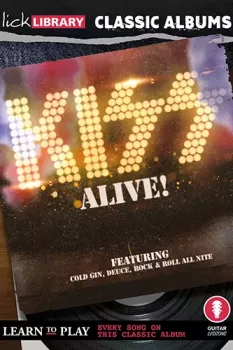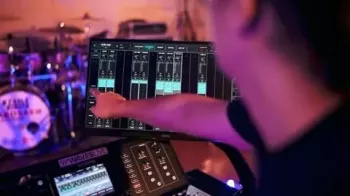
Alive, released in 1975, is a monumental live album by the iconic rock band KISS. From the thrilling riffs to the electrifying solos, the album captures the band’s raw energy and showcases the phenomenal skills of the band’s lead guitarists: Paul Stanley and Ace Frehley. With a selection of the best tracks from the first three studio albums, Kiss, Hotter Than Hell and Dressed To Kill, Alive! is a monument to the rock n roll majesty of KISS and spawned live versions of classic tracks which became legendary in their own right.
Licklibrary veteran tutor, Danny Gill walks you through one of the greatest live albums ever recorded in HD video lessons, bringing you step by step guitar lessons for some of the most beloved KISS songs of all time; from the famous live version of Rock And Roll All Nite to fan favourites such as Deuce and Cold Gin. You wanted the best? You got the best! In this article, we’ll dissect each song from the album and delve into the guitar techniques that make Alive a must-listen for any guitarist.
Song-by-Song Analysis
Deuce
“Deuce” kicks off the album with a powerful riff in the key of A Mixolydian. Paul Stanley plays rhythmic, palm-muted power chords, while Ace Frehley’s lead guitar soars with bends and vibrato that give the song its bluesy edge.
Strutter
“Strutter” is an upbeat track featuring the use of E Dorian and E Mixolydian scales. The song is driven by a catchy chord progression, including power chords and barre chords. Frehley’s solo combines alternate picking with legato phrasing, resulting in a smooth, fluid sound.
Got to Choose
“Got to Choose” is a bluesy track in the key of A Mixolydian, featuring a mix of power chords and open chords. Frehley’s lead guitar showcases his skills with bluesy double-stop bends, unison bends, and pinched harmonics.
Hotter Than Hell
This song features a heavy, chugging riff in the key of A Phrygian dominant. Frehley’s lead work employs tremolo picking and slides to create a sinister, aggressive sound.
Firehouse
“Firehouse” is characterized by its driving rhythm and a memorable riff in the key of G Mixolydian. Stanley’s rhythm guitar work combines power chords with palm muting, while Frehley’s lead guitar uses hammer-ons, pull-offs, and trills to add flair to his solos.
Nothin’ to Lose
This track features a bouncy, syncopated rhythm in the key of A Mixolydian. The lead guitar work shines with octave melodies and galloping rhythms, making it a standout track on the album.
C’mon and Love Me
“C’mon and Love Me” is a catchy, upbeat track in the key of E Mixolydian. Frehley’s lead guitar work combines alternate picking with legato phrasing and double-stops for a smooth, melodic sound.
Parasite
“Parasite” showcases a heavy riff in the key of A Phrygian. The rhythm guitar employs power chords and palm-muted chugging, while Frehley’s lead guitar utilises sweep picking and two-handed tapping techniques to create a captivating, high-energy solo.
She
This song features a slow, moody riff in the key of B Mixolydian. Frehley’s lead guitar work employs string bending, pre-bends, and vibrato for a bluesy, emotional sound.
Watchin’ You
“Watchin’ You” is an upbeat track in the key of E Mixolydian, featuring driving power chords and syncopated rhythms. Frehley’s lead guitar work displays a mix of alternate picking, legato techniques, and arpeggiated chord progressions.
100,000 Years
“100,000 Years” showcases a memorable, groovy riff in the key of A Dorian. Frehley’s lead guitar combines whammy bar tricks, dive bombs, and harmonics to create an otherworldly, spacey sound.
Black Diamond
“Black Diamond” closes the album with a powerful, anthemic chord progression in the key of G Mixolydian. The rhythm guitar features open-string riffs and power chords, while Frehley’s lead guitar work is characterised by dual guitar harmonies and sustain to create an epic, soaring sound.
The Lead Guitarists: Paul Stanley and Ace Frehley
Paul Stanley and Ace Frehley’s guitar work on Alive is nothing short of exceptional. Their distinct playing styles complement each other, resulting in a rich and diverse guitar sound throughout the album.
Paul Stanley, the band’s rhythm guitarist, is known for his powerful riffs and chord progressions. His playing is characterised by tight palm-muted power chords and barre chords, providing a solid foundation for the band’s hard-hitting sound.
Ace Frehley, the lead guitarist, is renowned for his unique, expressive playing style. His solos are packed with bends, vibrato, and harmonics, creating a captivating, melodic sound that has become synonymous with KISS. Frehley’s impressive technical skills are evident in his use of techniques like sweep picking, two-handed tapping, and tremolo picking.
Together, Stanley and Frehley form a dynamic guitar duo that gives Alive its distinct, unforgettable sound.





